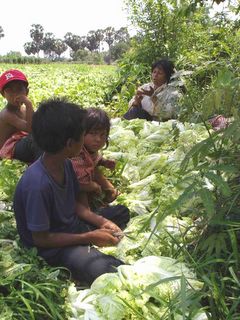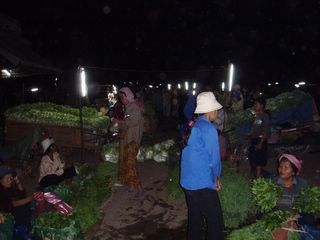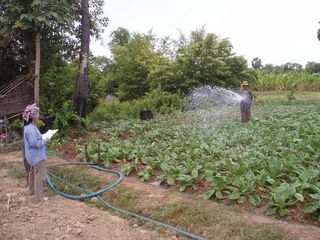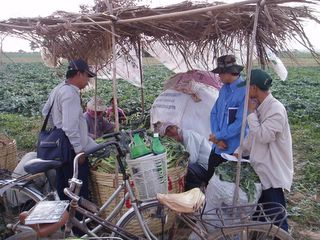Moving Vegetables Part II
Storing, transporting, and selling produce in tropical heat using Cambodia’s “roads” can be a pretty daunting task. Given the limited tools available here, it’s a given that a substantial amount of food will be lost in the process. In Cambodia, where forty-five percent of children are malnourished and the World Food Program is once again trying to ward off starvation by distributing rice to drought stricken provinces, this is no small matter.
To improve the supply of food and increase incomes in rural areas, one can try to raise more crops or one can try to improve the distribution network. Both options have their positive and negative points. Recently, some groups here have started to take an interest in how crops are packaged and transported for sale after harvest. The Centre d’Études et de Développement Agricole Cambodgien (CEDAC) just completed a year long study. Still, the details can be sketchy. This is especially the case for one of the most perishable types of produce, green leafy vegetables. For the past six weeks I’ve been working on a research study commissioned by AQIP, a division of the Australian Assistance in International Development (AusAID) program. The hope is that by knowing where damage occurs, we can develop a simple affordable solution to the problem.
Our first step was a series of unstructured interviews with farmers, collectors, wholesalers, and retailers operating in the Kien Svay and Saang districts just outside of Phnom Penh. Thanks to Cambodia’s annual cycle of droughts and flooding, farmers in Saang can use their fields for only about five months of the year. Farmers in Kien Svay are luckier. Their fields usually remain unflooded for nine months of the year. On my first day in Saang I met a farmer named Ol-ong. Kimsan, Sunday, and I found her sitting by the side of her field with her children, cutting out the white cores from the lettuce plants she’d just harvested. She had two fields that she harvested about three times each year. Based on what she told me that day, her family income from these was about $1.32USD per person per day. Unfortunately, when we found her that day, insects had recently devoured both her fields. In one stroke of bad luck, $1.32USD became about eighty-eight cents. Her children, helping her husk what was left of her crop, were the first I had found here who didn’t smile back. Ol-Ong, for her part chatted amicably with us, telling us about her livelihood, commenting that next time she would farm long beans instead.
The interviews continued for another week. We learned that in the time a green-leafy vegetable crop is harvested until the time it reaches market, there is a twenty-four hour window. After one day, the crop withers to the point of worthlessness. For this reason, transporting and selling is a twenty-four hour process. Crops are harvested during the daytime, stored at the home of a collector until about 1:00am and then transported to the market to be bought in bulk by retailers and wholesalers. By 6:00am, shops in the market begin to open and produce is sold throughout the following day.
Because of this twenty-four hour schedule, we needed a team of surveyors capable of conducting our initial researches both day and night. We had just enough of a budget and connections to get a team of five men assembled quickly, with two days initially scheduled for training. On the first day, the whole team quit.
Veasna, was translating some information for me when one of the surveyors interrupted with a question. “What security do we provide for working at night?” I was completely unprepared. “Hmm… we don’t have any,” I replied, “There’s no budget for that…” Veasna and the surveyors began laughing hysterically. “Three of them just quit,” he told me between chuckling gasps for air. I began giggling too. In Khmer society, it was the only possible response. Veasna fled the scene to seek help from Kimsan. Kimsan arrived, managing about two sentences before he too was laughing hysterically.
“The others, they quit too and I told to them that since they cannot work for us, we cannot pay them for today,” Kimsan told me, slapping me repeatedly on the shoulder to make sure I got the joke. Chuckling with the same hopeless laugh I used to use before an exam for which I hadn’t properly prepared, I asked, “Why did they all just quit?” and “What do we do now?”
“They say they did not know they have to work nights. I tell them because cannot pay, we buy for all of us lunch together.” Excessive awkward giggling aside, the lunch was tasty and happily, by the next week, we had found a survey team composed of three men and two women, willing to work nights, with a very good knowledge of both the Saang and Kien Svay districts. All of them had previous experience consulting for AQIP. Unfortunately, this seemed to mean that rather than quitting on the first day, they found a thousand and one reasons to explain to us why none of our questions, measurement plans, or other items in the survey could work. In many cases, I was grateful for their greater experience and insight. In others, their worries bordered on the ridiculous.
“But how can I measure weight at nighttime, while writing down measurements with one hand and holding a flashlight with the other? I would need three hands!”
“Can you maybe hang the vegetables from the portable scale with one hand and hold the light with the other? Then you could put scale down, pick up the pen and remember the number you just saw.”
During the countless times in which we were told that there was no way to take even the most essential basic weight and temperature measurements for the study, the giggling never stopped. We eventually settled on a simple, let’s try it and see if it’s possible approach. We’ve now completed a little over half the study, and though we’ve had to reduce the number of people to be interviewed, we’ve nevertheless managed through regular meetings and supervisory assistance in the field to collect the most essential data.
In the meantime, my experiences with Ol-ong and other farmers have left me skeptical about the relative importance of packaging in addressing the problem. Though from the initial data I’ve seen, rates of spoilage may be close to 20%, most of the people with whom I’ve talked insist that little to no spoilage occurs at any point from harvest to market. Even if we do find a big problem with an easy solution, this raises the question of how do we market it to a group of people who don’t see the need?
My current feeling is that insects are one of the biggest problems. While interviewing a farmer last week, Kimsan spotted a discarded Thai insecticide box covered in warning symbols. “Use 20cc for 20 litres,” he translated for me. “Still, you can see insects have eaten his crop,” I responded, “Maybe we should ask him about this?” Kimsan chatted with the farmer for a moment before responding, “He say that he use 20cc for 20 litre but still have insect, so instead he take one whole package, 100cc and mix with only 15 litre.”
A nearly sevenfold increase in pesticide use! We both took a step back from the vegetable patch.
“Still it do not work well,” Kimsan added. Judging by this man’s crop and others I’ve seen using similar amounts of similar products, he was right. IDE’s recently started investigating an alternative organic pesticide, a by-product of burning fuelwood, but more on that if and when I have some results to share.
In the meanwhile, thankfully, we’ve embarked on this study without many preconceptions, acknowledging a problem and trying to see if a viable solution is possible from this direction. On the still more positive side, I made certain to include a few very open-ended questions in the questionnaire regarding problems in our respondents’ livelihoods. Though the answers may have nothing to do with packaging or transport, they'll help us to know if we’re going down the wrong path and may even give us a hint as to what the right one is.





0 Comments:
Post a Comment
<< Home